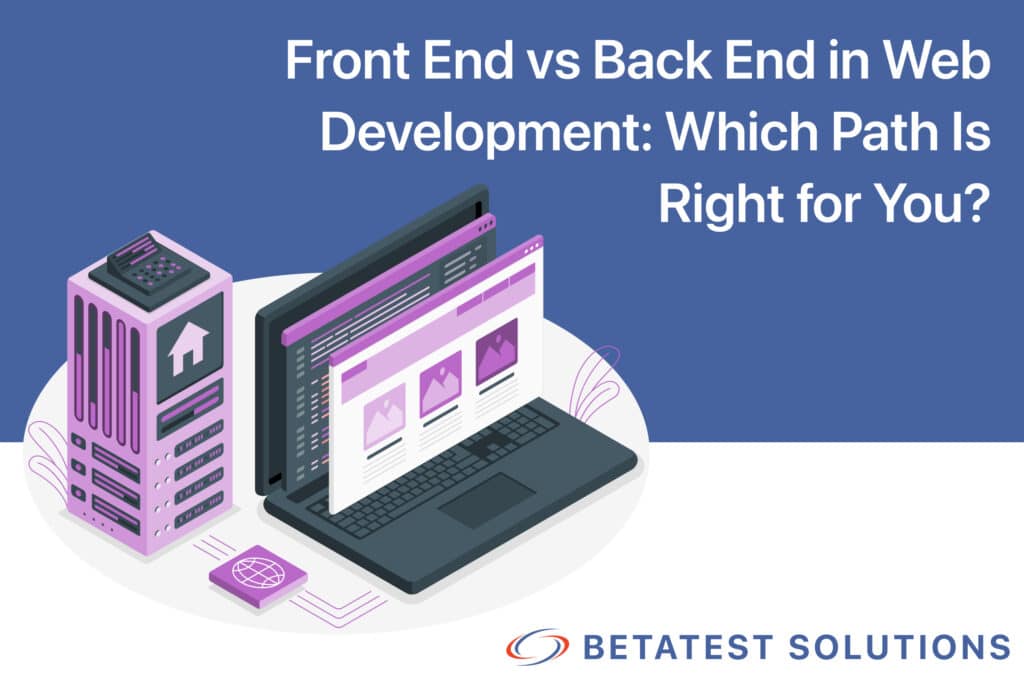Are you interested in knowing about a career in web development? This is an excellent development since there are a multitude of opportunities inside this fiercely competitive sector. Prior to commencing, it is important to make a consequential decision: would you choose to focus on the front-end development or the back-end development of the website?
In the huge and always-changing field of web development, there are two separate areas that are very important for making the digital world come to life.
These realms are known as “back-end” and “front-end” web development.
Despite the fact that they all aim to produce websites that are useful and aesthetically pleasing, they are as unlike as night and day. At BetaTest Solutions, we are aware of the difficulties involved in web development and how crucial it is for staff members on a website’s front end and back end to collaborate to provide top-notch online solutions. We’ll examine the key distinctions between front-end and back-end web development in this piece.
The Basics of Front-End and Back-End Web Development:
Before we go into the specifics of the distinctions between back-end and front-end software, let’s obtain a general understanding of both types.
Front-end Development
“Front-end development,” sometimes known as “client-side” development, is the part of website development that focuses on the elements of the website that users see and interact with while they are on it. The creation of the user interface (UI) and the facilitation of a smooth user experience (UX) are both parts of this process. Programming languages like HTML, CSS, and JavaScript are used by front-end specialists at BetaTest Solutions to create web pages that are functional and visually beautiful.
Back-end Development
It is important to talk about this branch of back-end web development, sometimes known as “server-side” development. This is the code that underpins how a website functions. The operation of the website, as well as the administration of servers and databases, are handled by staff members in this division. Server-side apps are made using frameworks like Node.js and other languages like Python, Ruby, and PHP. These programs may do everything from data management to user activity monitoring.
The Key Differences
Now, let’s dive into the key differences these fields have to provide:
| Terminologies | Front-End | Back-End |
Focus and Responsibility |
Creating visual elements of a site that can interact with the audience is all taken care of by the Front-end developers. Here, designing the layout, implementing responsive design, and ensuring cross-browser compatibility all are included. The focus would all be on the user interface and user experience. | Back-end developers, on the other hand, deal with the server, databases, and server-side logic. They ensure that data is stored, processed, and delivered efficiently. Their primary focus is on server-side functionality, security, and data management. |
Technologies |
Front-end developers work with HTML for structure, CSS for styling, and JavaScript for interactivity. They also utilize various front-end frameworks and libraries like React, Angular, or Vue.js to streamline development. | Back-end developers work with server-side programming languages like Python, Ruby, PHP, or Java. They use frameworks like Django, Ruby on Rails, Laravel, or Express.js to expedite development. They are also responsible for managing databases using systems like MySQL, PostgreSQL, or MongoDB. |
User Interaction |
The front-end is where user interaction primarily occurs. front-end developers ensure that the website is visually appealing, responsive, and user-friendly. They handle animations, form validation, and client-side data processing. | Back-end developers are concerned with the processes that happen behind the scenes, such as handling user requests, processing form data, and interacting with databases. They ensure that data is securely transmitted between the user’s device and the server. |
Security |
Front-end developers deal with client-side security, such as protecting user data through encryption and securing login forms. They also contribute to security by validating user inputs on the client side to prevent common vulnerabilities like cross-site scripting (XSS). | Back-end developers are responsible for server-side security, protecting databases from unauthorized access, implementing authentication and authorization systems, and safeguarding against threats like SQL injection and server-side scripting attacks. |
Testing and Debugging |
Front-end developers primarily focus on testing user interfaces across various browsers and devices. They use tools like Chrome DevTools and various browser extensions for debugging. | Back-end developers focus on testing server-side logic and database operations. They use testing frameworks like Jest, Mocha, or PHPUnit to ensure that the server responds correctly to different scenarios. |
Collaboration |
Front-end developers often collaborate closely with designers to ensure that the website’s visual design aligns with the intended user experience. They also work alongside back-end developers to integrate front-end and back-end systems seamlessly. | Back-end developers collaborate with front-end developers to define APIs (Application Programming Interfaces) that allow data to flow between the server and the client. They also work with database administrators to optimize data storage and retrieval. |
The Harmony of Web Development
While back-end and front-end development have distinct roles and responsibilities, they are intricately linked, relying on each other to create a fully functional website. At BetaTest Solutions, we understand that effective collaboration between these two domains is pivotal for delivering an exceptional user experience.
Full Stack Developers
In addition to front-end and back-end developers, there are full-stack developers who possess proficiency in both domains. Full-stack developers can work on the entire web development stack, from the user interface to the server and database. They are versatile and can tackle a wide range of tasks, making them valuable assets in web development projects.
Conclusion
When it comes to web development, back-end development and front-end development are like night and day. However, both are necessary for making a website work. Back-end developers take care of the server, databases, and server-side code, while front-end developers work on the user experience and the look and feel of the site.
Understanding these important differences helps web development teams work together well, making sure that the user experience and server-side functions work together without any problems. As a front-end developer, back-end developer, or full-stack developer, you’re all very important to building the web we use every day. These jobs work together to make the internet a living place, one page at a time.
At BetaTest Solutions, we use this synergy to create cutting-edge web solutions that combine beautiful design with powerful features, giving people the best online experiences possible. Back-end and front-end software are different in some ways, but they work together to make the digital fabric that is our internet world.




